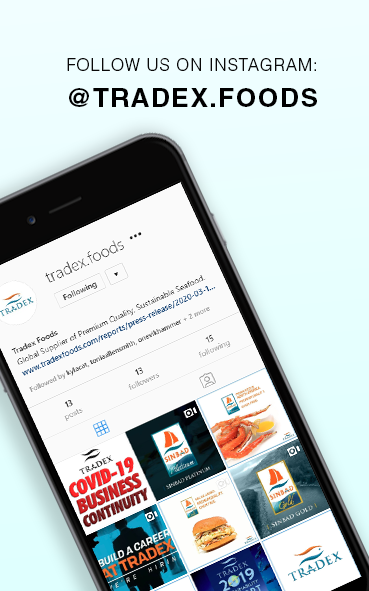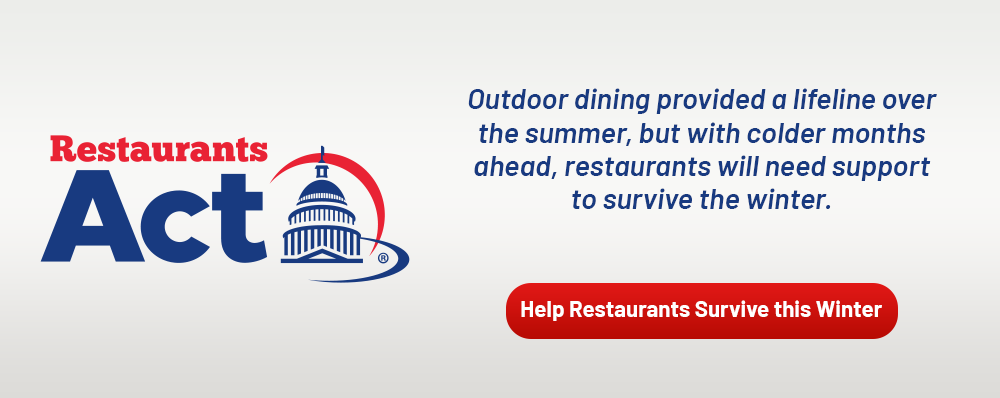
Loading
EP 516 | AIRED 11/30/2020
How Much Food Can The Ocean Sustainably Provide By 2050?
November 30th, 2020 --- In the year 2050, Earth will have almost 10 billion humans who will eat over 500 billion kilograms of meat.
With land-based meat fraught with climate and environmental impacts, how much animal protein can be sustainably supplied by the ocean?
This week we speak with the University of Washington's Sustainable Fisheries’ Editor Max Mossler on what will be one of the most cited papers in the next decade.
'The future of food from the sea' (Costello et al. 2020) is an important paper that roadmaps improved fishery management and mariculture reform to produce as much animal protein from the sea that we can.
--- The demand our multi-billion global population puts on the planet for protein increases exponentially each year.
By the year 2050, it's presumed that we're going to need around 500 billion kilograms of meat, and at the moment, we supply the majority of our demand for protein by means of land-based agriculture.Unfortunately, the farming of meat is one of the most harmful and carbon-emitting industries in the world.
Not only does it harm our environment, it requires a massive amount of dedicated land, competing with own needs and the habitats of other animals.
The ocean not only provides a vastly larger space for aquatic farming, but the sustainability of the species like scallops and mussels who feed themselves and filter water as they grow, are endless.
A paper released in Nature titled, The Future of Food from the Sea, calculates that the ocean could sustainably provide 80-103 billion kilograms of food, a 36-74% increase compared to the current yield of 59 billion kilograms, if we begin following these 4 steps:
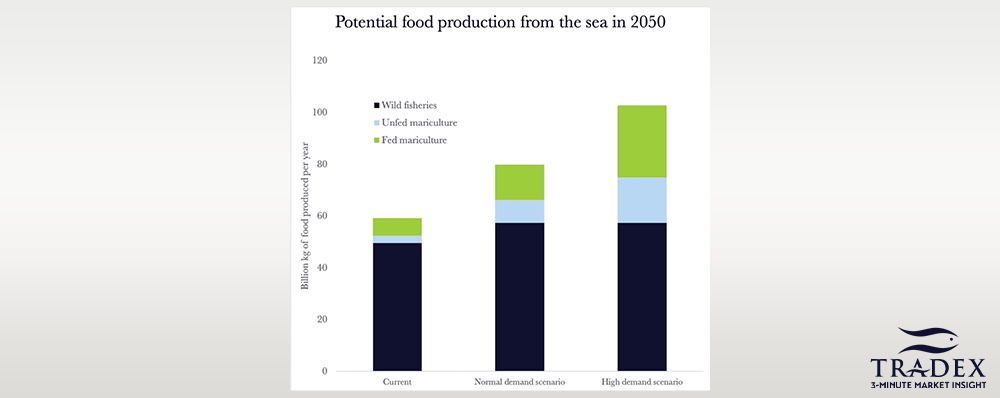
1. Improve fishery management.
2. Implement policy reforms to address mariculture.
3. Advance feed technologies for fed mariculture.
4. Shift consumer demand.
"Each one of those things can happen right now, it's not a progression of steps, they can all start now.
It's not too late at all, it will require a lot of buy-in from governments and from NGOs and Companies and will be a collective effort.
---- [Fishery Management] A very important paper came out this year, with Ray Hilborn as the lead author on it, showing that Fisheries that are simply monitored do really well, that's the first step of fishery management, is knowing what the stock is doing, bio mass is the first step.
Countries that are able to monitor their fisheries, have more sustainable fisheries, and the ones that don't due to poverty, don't have the capacity to monitor their fisheries and generally do poorly.
There's a role that countries with good fisheries management have here, they can help other countries who are struggling, and monitoring is the first step.
Unfed mariculture, I would argue, is the most sustainable food on the planet, plant, animal, anything, it is the most sustainable food.
It is absolutely crazy that mussels are not an integral part of everyone's diet, they are so good for you, they’re healthy and they filter the sea water and make it cleaner.
---- [Feed technology] The most sustainable way to grow fish is to use the least amount of food, or use food that is low impact.
right now a lot of the food that is fed comes from wild fisheries, which are reduction fisheries, like the Peruvian Achoveta which is all turned into fish meal and eventually become Salmon.
There is an environmental impact there, certainly compared to unfed mariculture, and there is a lot of research being done into how do we reduce the amount of wild fisheries that we feed to aquaculture species, can we use something that’s lower impact, can we feed them plants, insects or algae.
---- [Policy reform] (Explaining Graphs that will be shown on screen) Wild fisheries is on the left, Fed mariculture in the middle and unfed on the right.
This basically shows how much we, as a global society, could produce sustainably and what can get us to that sustainably.
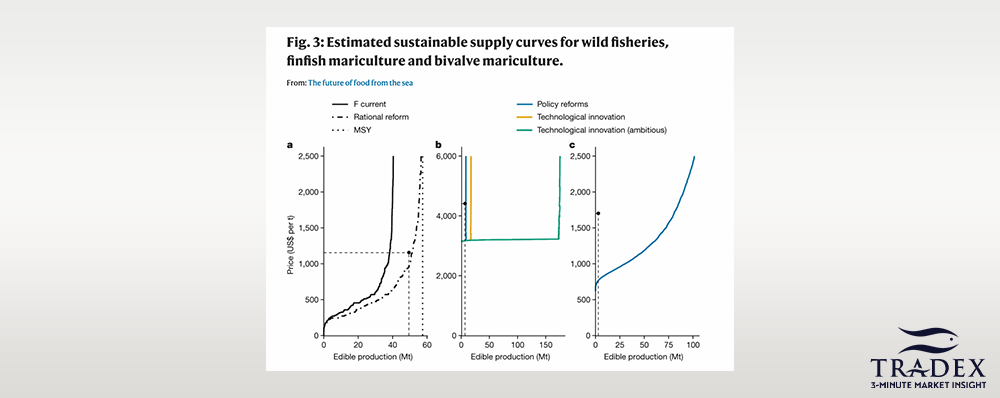
for wild fisheries on the left, right now we produce a little over 50 Megatons of food and we can increase that to over 60 with some fisheries management reform around the world.
That’s how we could maximize the amount of sustainable wild fish that we get by reforming management.
The middle figure is showing fed mariculture, and how much edible production we could create by using policy reform, tech innovation which is highly ambitious.
Fed mariculture produces about 7 Megatons of food and we need to increase that, so using policy reforms gets us more, and with both that plus tech reforms like making fish farming more efficient with less feed, it goes to about 17 MT.
And if somehow we are able to reduce wild fish inputs into farmed fish by 95%, which is super ambitious, we could have well over 150 Megatones of food, which is more than enough protein to feed 10 billion people.
And on the right it shows unfed mariculture, which I'm such a fan of because all it requires is policy reform, the more policy reform that we have, the more seafood we get, and the limit does not exist.
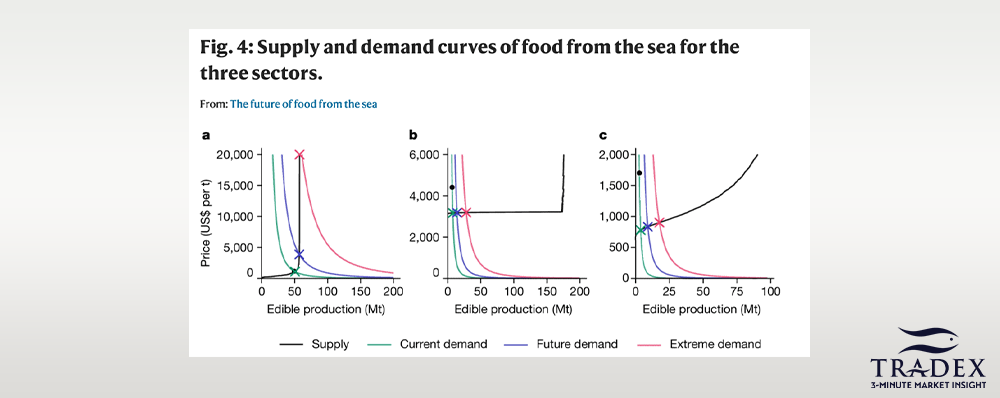
You can see we only get 3 Megatones of food comes from unfed mariculture, but the potential for that is really high.
What’s really important about these is that there are price next to them, so supply of what is possible economically and one of the reasons this paper is so important is it doesn’t just show what’s possible biologically, it shows what's possible biologically under different price scenarios, which is much more realistic, so we have some realism with the science, which is really great."
- Max Mossler, MMA, Sustainable Fisheries UW.
--- As a company with a goal of promoting sustainable eating, we feel that it is our responsibility to shift consumer demand towards using seafood as your primary source for protein.
The seafood industry is leading the way for sustainable protein suppliers around the world to follow suit, and utilise the full potential of our oceans and resources that we have available, with much less impact than we are seeing now.
Not only will it benefit the environment, it's a healthier protein than red or white meat, and can still satisfy a hungry customer.
Keep tuned in to our 3-Minute Market Insight as we keep you up to date on the latest trends in Sustainable Seafood and how it will effect the industry.


